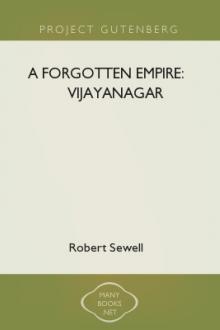A Forgotten Empire: Vijayanagar by Robert Sewell (short story to read TXT) 📕

- Author: Robert Sewell
- Performer: -
Book online «A Forgotten Empire: Vijayanagar by Robert Sewell (short story to read TXT) 📕». Author Robert Sewell
“In the front of this place rose a palace with nine pavilions magnificently ornamented. In the ninth the king’s throne was set up. In the seventh was allotted a place to the humble author of this narrative…. Between the palace and the pavilions … were musicians and storytellers.”
Girls were there in magnificent dresses, dancing “behind a pretty curtain opposite the king.” There were numberless performances given by jugglers, who displayed elephants marvellously trained.
During three consecutive days, from sunrise to sunset, the royal festival was prolonged in a style of the greatest magnificence. Fireworks, games, and amusements went on. On the third day the writer was presented to the king.
“The throne, which was of extraordinary size, was made of gold, and enriched with precious stones of extreme value…. Before the throne was a square cushion, on the edges of which were sown three rows of pearls. During the three days the king remained seated on this cushion. When the fete of Mahanawi was ended, at the hour of evening prayer, I was introduced into the middle of four ESTRADES, which were about ten ghez both in length and breadth.[147] The roof and the walls were entirely formed of plates of gold enriched with precious stones. Each of these plates was as thick as the blade of a sword, and was fastened with golden nails. Upon the ESTRADE, in the front, is placed the throne of the king, and the throne itself is of very great size.”
The descriptions given by these travellers give us a good idea of the splendours of this great Hindu capital in the first half of the fifteenth century; and with this in our minds we return to the history of the period.
CHAPTER 8
Close of the First Dynasty (A.D. 1449 to 1490)
Mallikarjuna and Virupaksha I. — Rajasekhara and Virupaksha II. — The Dakhan splits up into five independent kingdoms — The Bijapur king captures Goa and Belgaum — Fighting at Rajahmundry, Kondapalle, and other parts of Telingana — Death of Mahmud Gawan — The Russian traveller Nikitin — Chaos at Vijayanagar — Narasimha seizes the throne.
I have already stated that the period following the reign of Deva Raya II. is one very difficult to fill up satisfactorily from any source. It was a period of confusion in Vijayanagar — a fact that is clearly brought out by Nuniz in his chronicle.
A.D. 1449 is the last date in any known inscription containing mention of a Deva Raya, and Dr. Hultzsch148 allots this to Deva Raya II. It may be, as already suggested, that there was a Deva Raya III. on the throne between A.D. 1444 and 1449, but this remains to be proved. Two sons of Deva Raya II., according to the inscriptions, were named Mallikarjuna and Virupaksha I. respectively. There are inscriptions of the former dated in A.D. 1452 — 53 and 1464 — 65,[149] and one of the latter in 1470.[150] Mallikarjuna appears to have had two sons, Rajasekhara, of whom we have inscriptions in the years A.D. 1479 — 80 and 1486 — 87, and Virupaksha II., mentioned in an inscription dated A.D. 1483 — 84, three years earlier than the last of Rajasekhara.
Dr. Hultzsch, in the third volume of the EPIGRAPHIA INDICA, p. 36, gives these dates, but in the fourth volume of the same work (p. 180) he notes that an inscription of Rajasekhara exists at Ambur in North Arcot, which is dated in the year corresponding to A.D. 1468 — 69. I have also been told of an inscription on stone to be seen at the village of Parnapalle (or Paranapalle) in the Cuddapah district, of which a copy on copper-plate is said to be in the possession of one Narayana Reddi of Goddamari in the Tadpatri Taluq of the Anantapur district. This is reported to bear the date Saka 1398 (A.D. 1476 — 77), and to mention as sovereign “Praudha Deva Raya of Vijayanagar.”
Rajasekhara’s second inscription must have been engraved very shortly before the final fall of the old royal house, for the first certain date of the usurper Narasimha is A.D. 1450.
Amid this confusion of overlapping dates we turn for help to Nuniz; but though his story, gathered from tradition about the year 1535, is clear and consecutive, it clashes somewhat with the other records. According to him, Deva Raya II. had a son, Pina Raya, who died six months after his attempted assassination; but we have shown that Abdur Razzak conclusively establishes that this unfortunate monarch was Deva Raya II. himself, and that the crime was committed before the month of April 1443. Pina Raya left a son unnamed, who did nothing in particular, and was succeeded by his son “Verupaca,” by which name Virupaksha is clearly meant. Virupaksha was murdered by his eldest son, who in turn was slain by his younger brother, “Padea Rao,” and this prince lost the kingdom to the usurper Narasimha.
The period was without doubt a troublous one, and all that can be definitely and safely stated at present is that for about forty years prior to the usurpation of Narasimha the kingdom passed from one hand to the other, in the midst of much political agitation, discontent, and widespread antagonism to the representatives of the old royal family, several of whom appear to have met with violent deaths. The usurpation took place at some period between A.D. 1487 and 1490.
Leaving the Hindu and Portuguese records, we must turn to the Muhammadan historians in order to see what were the political relations existing at this time between Vijayanagar and its hereditary enemies to the north. Firishtah tells us of no event occurring between the year 1443 and 1458 A.D. to disturb the peaceful conditions then existing. Kulbarga was itself in too troubled a condition to venture on further national complications. Internal disputes and civil war raged in the Dakhan, and the country was divided against itself. The trouble had begun which ended only with the extinction of the Bahmani monarchy, and the establishment of five rival Muhammadan kingdoms in the place of one.
Ala-ud-din died February 13, A.D. 1458, (?)[151] and was succeeded by his son Humayun, a prince of “cruel and sanguinary temper.” In the following year Humayun waged war against the country of the Telugus and besieged Devarakonda, which made so stout a resistance that the Dakhani armies were baffled, and retired. He died on the 5th September 1461,[152] to the great relief of all his subjects. Mallikarjuna appears to have been then king of Vijayanagar.
Nizam Shah succeeded to the throne, being then only eight years old, but his reign was of short duration. He was succeeded by his brother Muhammad on July 30, A D. 1463,[153]
In the middle of the year 1469, while either Rajasekhara or Virupaksha I. was the king of Vijayanagar, Mahmud Gawan, Muhammad’s minister, marched towards the west, and after a fairly successful campaign attacked Goa, then in the possession of the Raya of Vijayanagar, both by sea and land. He was completely victorious and captured the place.
The war was probably undertaken in revenge for a cruel massacre of Muhammadans which took place in this Year A.D. 1469, according to Barros.[154] At this period the coast trade was altogether in the hands of the Muhammadans, and they used to import large numbers of horses, principally for the use of the great contending armies in the Dakhan and Vijayanagar. The Hindu king depended on this supply to a large extent. In 1469 the Moors at Batecala (Bhatkal) having sold horses to the “Moors of Decan,” the king of Vijayanagar ordered his vassal at Onor (Honawar) “to kill all those Moors as far as possible, and frighten the rest away.” The result of this was a terrible massacre, in which 10,000 Musulmans lost their lives. The survivors fled and settled themselves at Goa, thus founding the city that afterwards became the capital of Portuguese India. Nuniz alludes to the loss of “Goa, Chaull, and Dabull” by Vijayanagar in the reign of “Verupaca.”[155] (Purchas states that the massacre took place in 1479 A.D.)
Shortly afterwards there arose to power under the Sultan Muhammad one Yusuf Adil Khan, a slave, who before long grew to such power that he overthrew the Bahmani dynasty, and became himself the first independent sovereign of Bijapur — the first “Adil Shah.” In 1470, says the BURHAN-I MAASIR, the Sultan took Rajahmundry and Kondavid from the king of Orissa. An inscription at Kondapalle, a fine hill-fort beautifully situated on a range of hills, gives the date as 1470 or 1471; my copy is imperfect.
Firishtah tells us that —
“In the year 877 (A.D. 1472 — 73) Perkna, roy of the fortress of Balgoan, at the instigation of the prince of Beejanuggur, marched to retake the island of Goa…. Mahummud Shaw, immediately upon intelligence of this irruption, collected his forces and moved against Balgoan, a fortress of great strength, having round it a deep wet ditch, and near it a pass, the only approach, defended by redoubts.”
The attack ended in the reduction of the place, when the Sultan returned to Kulbarga.
The BURHAN-I MAASIR CALLS the chief of Belgaum “Parkatapah,” and Major King, the translator of the work, gives a large variety of spellings of the name, viz.: “Birkanah,” “Parkatabtah,” “Parkatiyah,” “Parkitah,” “Barkabtah.”[156] Briggs gives it as “Birkana.” It has been supposed that the real name was Vikrama.
About the year 1475 there was a terrible famine in the Dakhan and the country of the Telugus, which lasted for two years. At its close the Hindu population of Kondapalle revolted, murdered the Muhammadan governor, and invited aid from the king of Orissa. This monarch accordingly advanced and laid siege to Rajahmundry, which was then the governorship of Nizam-ul-Mulkh, but on the Shah marching in person to the relief of the place the army of Orissa retired. In the latter part of the year 882, which corresponds to March 1478 A.D., Muhammad penetrated to the capital of Orissa, “and used no mercy in slaughtering the inhabitants and laying waste the country of the enemy.” The Rajah submitted, and purchased his immunity from further interference on the part of the Sultan by a present of some valuable elephants.
Firishtah and the BURHAN-I MAASIR differ considerably as to what followed. The former states that, after his raid into Orissa, Muhammad Shah reduced Kondapalle, where he destroyed a temple, slew the Brahman priests attached to it, and ordered a mosque to be erected on its site. He remained nearly three years at Rajahmundry, secured the Telingana country, expelled some refractory zamindars, and “resolved on the conquest of Nursing Raya.”
“Nursing,” says Firishtah, “was a powerful raja, possessing the country between Carnatic157 and Telingana, extending along the sea-coast, to Matchiliputtum,[158] and had added much of the Beejanuggur territory to his own by conquest, with several strong forts.”
This was probably the powerful chief Narasimha Raya, a relation of the king of Vijayanagar, who, intrusted with the government of large tracts, was rising rapidly to independence under the weak and feeble monarch whom he finally supplanted. The Sultan went to Kondapalle,[159] and there was told that, at a distance of ten days’ journey, “was the temple of Kunchy,[160] the walls and roof of which were plated with gold, ornamented with precious stones;” upon receipt of which intelligence the Sultan is said to have made a forced march thither, taking with him only 6000 cavalry, and to have sacked the place.
The account given by the BURHAN-I MAASIR as to Muhammad Shah’s proceedings at this period is that on going





Comments (0)